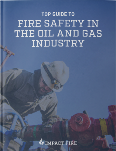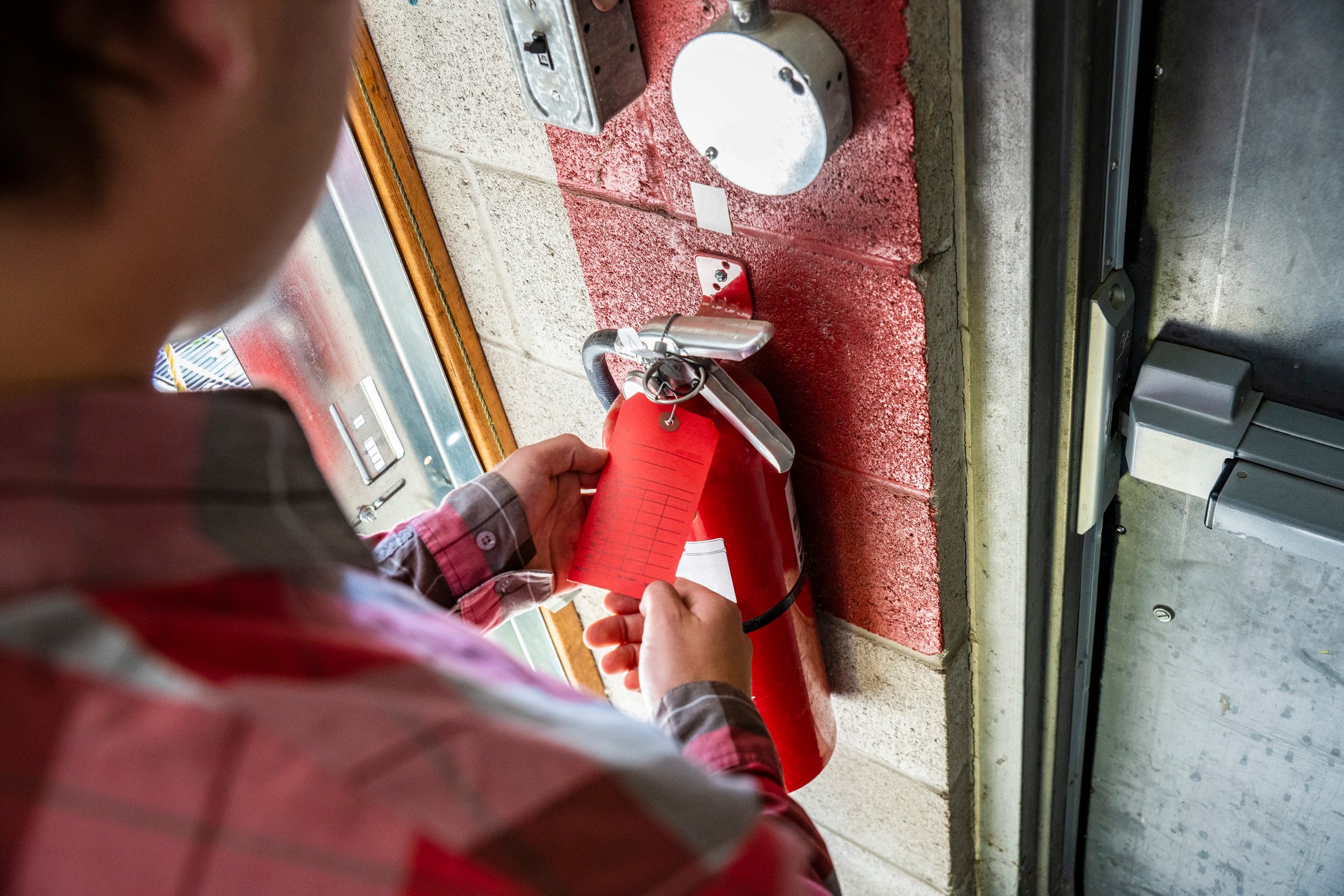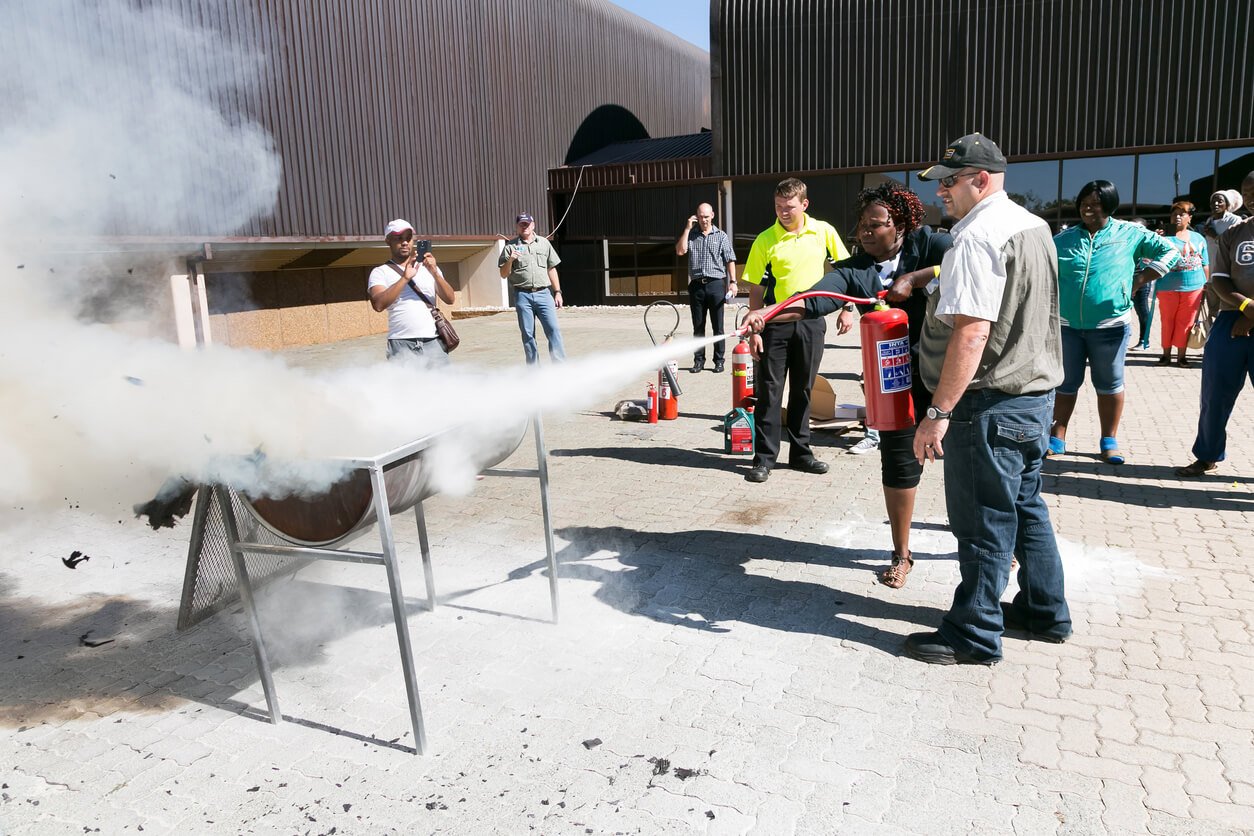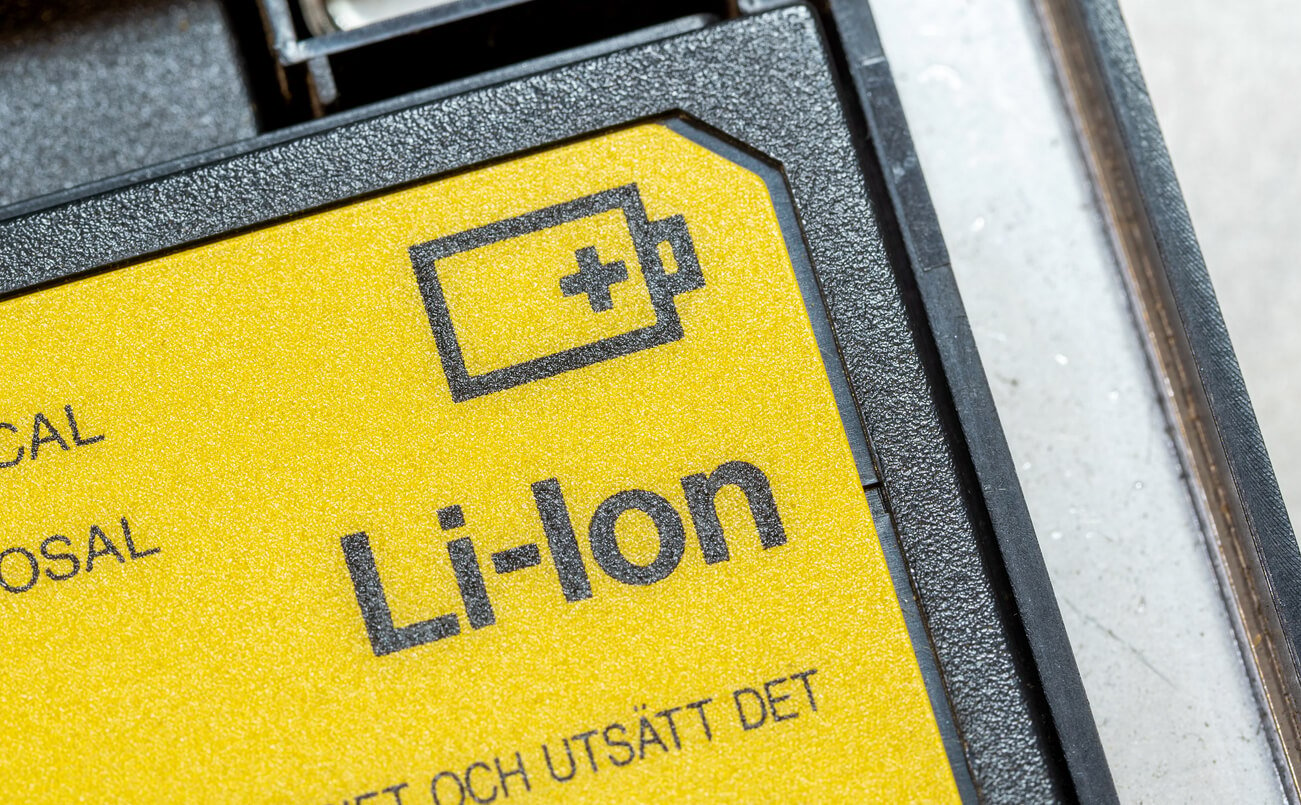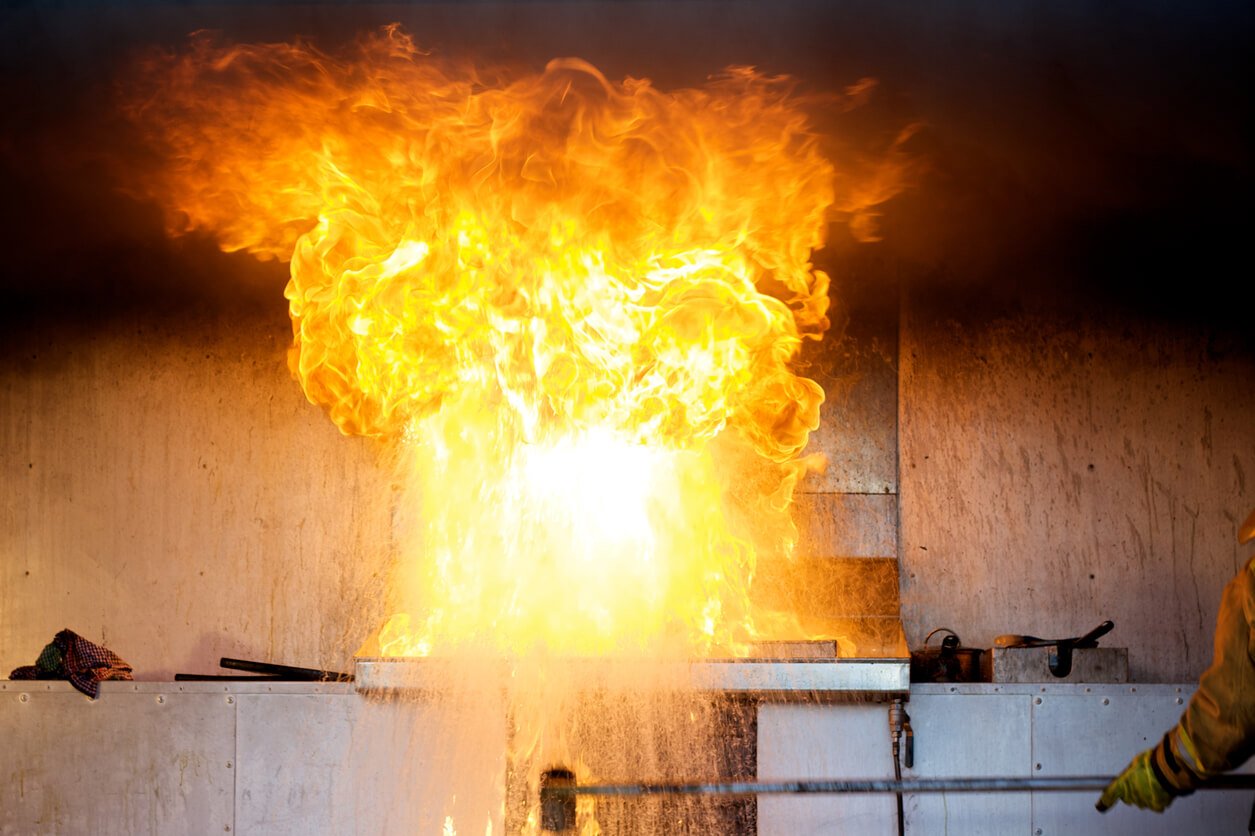How Long Do Fire Extinguishers Actually Last?
Disposable fire extinguishers should be replaced every 12 years, while rechargeable units require recharging every 6 years and can achieve 10-12 year lifespans with proper maintenance.
The average lifespan depends on environmental conditions, maintenance quality, and fire extinguisher type rather than a fixed expiration date.
If a fire breaks out, you need to be confident that your equipment will work as expected.
One of the most important devices you (or a designated employee) would operate is a portable fire extinguisher.
If it’s undercharged, expired, or depressurized, it could cause issues with the efficacy of your suppression efforts.
How will you know if your fire extinguisher is “expired”? And how can you proactively check to ensure it’s working properly?
Let’s find out.
Key Takeaways
- Disposable fire extinguishers require replacement every 12 years, while rechargeable fire extinguishers need recharging every 6 years and can serve up to 12 years with proper maintenance.
- Any fire extinguisher manufactured before 1955, containing toxic chemicals like carbon tetrachloride, or requiring inversion to operate should be removed from service immediately to avoid liability and compliance issues.
- Building owners should verify that pressure gauges remain in the green zone and address any units showing "Recharge" or over-pressurized readings before they fail during emergencies.
- Hydrostatic testing, annual inspections, and planned replacements cost significantly less than emergency fire damage, insurance claim denials, or OSHA violation fines.
- Partnering with qualified fire protection professionals provides comprehensive coverage while optimizing costs and maintaining current safety standards.
Do Fire Extinguishers Expire?
The simple answer is yes, fire extinguishers "expire" but not in the way you're thinking. Unlike food products, fire extinguishers don't have a typical expiration date. While portable fire extinguishers don't expire in the typical sense, certain models become obsolete as technology advances and regulations change.
Fire extinguishers follow a complex system of service life requirements rather than traditional expiration dates. The National Fire Protection Association (NFPA) establishes these guidelines to ensure fire protection equipment maintains its effectiveness over time. According to NFPA 10 standards, fire extinguishers require specific maintenance schedules and eventual replacement based on their type and construction.
The confusion around fire extinguisher expiration stems from the fact that extinguishing agents themselves typically don't degrade over time. Dry chemical powder, water, and carbon dioxide remain effective for decades when properly stored.
However, the mechanical components that deliver these agents—pressure vessels, valves, hoses, and gauges—experience wear and degradation that affects functionality.
The question isn't simply whether fire extinguishers expire, but rather when building owners should proactively replace them to maintain optimal fire protection. Understanding this timeline requires knowledge of different fire extinguisher types, maintenance requirements, and regulatory standards that govern commercial fire protection systems.
How Long Do Fire Extinguishers Last?
Fire extinguisher life expectancy varies from manufacturer to manufacturer and depends on several additional factors, including:
- Type of fire extinguisher
- Whether it is rechargeable or disposable
- The extent of maintenance over time
- Manufacture date (when it was built)
- Manufacturer's recommendation for replacement
Most manufacturers claim a properly maintained fire extinguisher has an average lifespan of 10-12 years. However, building owners should understand that this timeframe depends heavily on environmental conditions, usage frequency, and adherence to maintenance schedules.
For example, fire extinguishers in harsh environments—such as areas with high humidity, temperature extremes, or corrosive substances—may require more frequent replacement regardless of their theoretical lifespan.
The 10-12 year average lifespan represents optimal conditions with regular professional maintenance. Fire extinguishers that receive annual inspections, proper storage, and timely repairs can achieve their full service life potential.
Conversely, neglected fire extinguishers may fail well before reaching these timeframes, creating gaps in fire protection coverage that building owners may not discover until an emergency occurs.
When Should You Replace Your Fire Extinguisher?
Based on National Fire Protection Association standards, building owners need to follow two critical fire extinguisher life expectancy guidelines.
- Disposable fire extinguishers should be replaced every 12 years
- Rechargeable fire extinguishers should be recharged every 6 years.
These timelines ensure that pressure systems remain intact and that extinguishing agents stay properly contained.
The decision between rechargeable and disposable units depends on building size, fire hazard types, and long-term maintenance budgets.
Large commercial properties typically benefit from rechargeable systems due to lower lifecycle costs and reduced waste generation.
Smaller buildings with minimal fire extinguisher requirements may find disposable units more practical due to simplified maintenance requirements.
Building owners should also consider that fire extinguishers will continue to function after these recommended periods. However, NFPA 10 and manufacturer service guidelines require periodic internal testing and recharging by qualified fire protection companies to ensure functionality and canister integrity.
Related Resource
Here's what you need to know about fire extinguisher recharging. Learn More →
Types of Fire Extinguishers and Their Specific Lifespans
Different types of fire extinguishers have varying service lives and maintenance requirements that directly impact building owner costs and compliance obligations.
Dry Chemical Fire Extinguisher Expiration
Dry chemical fire extinguishers represent the most common type found in commercial buildings. These units typically contain monoammonium phosphate or sodium bicarbonate powder and offer excellent versatility for Class A, B, and C fires.
Rechargeable dry chemical extinguishers can serve building owners for 12 years with proper maintenance, while disposable units require replacement after 12 years regardless of usage. The dry chemical powder itself remains effective indefinitely, but pressure systems and mechanical components degrade over time.
Water-Based Fire Extinguishers
Water extinguishers provide cost-effective protection for Class A fires involving ordinary combustibles like wood, paper, and fabric. These units generally last 5-6 years for disposable models and up to 12 years for rechargeable versions with regular hydrostatic testing every 5 years.
Building owners should note that water extinguishers cannot be used on electrical fires, limiting their applications in modern commercial facilities with extensive electrical systems.
CO2 Fire Extinguishers
Carbon dioxide extinguishers excel at protecting electrical equipment and flammable liquid hazards without leaving residue that could damage sensitive electronics. CO2 extinguishers typically require hydrostatic testing every 5 years and can achieve 10-12 year service lives with proper maintenance.
The carbon dioxide gas doesn't expire, but high-pressure cylinders experience metal fatigue that eventually compromises safety and effectiveness.
What Types of Fire Extinguishers are Considered Obsolete?
Fire extinguishers become outdated as technology advances and regulations change to address newly discovered safety hazards.
Many older fire extinguishers contain toxic chemicals, use dangerous operating mechanisms, or lack modern safety features that protect users during emergency situations.
Building owners who maintain obsolete fire extinguishers face significant liability exposure and potential code violations that could result in fines or insurance claim denials.
NFPA provides guidelines for which types of extinguishers are considered obsolete and should be removed from service.
Some of these include:
- Soda Acid
- Chemical Foam
- Vaporizing Liquids (Carbon Tetrachloride)
- Cartridge-operated water
- Cartridge-operated loaded stream
- Copper or brass shell (excluding pump tanks) joined by soft solder or rivets
- Carbon dioxide extinguishers with metal horns
- Solid charge type AFFF (paper cartridge)
- Pressurized water extinguishers manufactured before 1971
- Any extinguisher that needs to be inverted to operate
- Any stored pressure extinguisher manufactured before 1955
- Any extinguisher with 4B, 6B, 8B, 12B, and 16B fire ratings
- Stored-pressure water extinguishers with fiberglass shells (pre-1976)
- Stored-pressure dry chemical extinguisher manufactured before October 1984
In addition to the types of extinguishers listed above, any fire extinguisher that can no longer be serviced following the manufacturer's maintenance manual, or was made by a company that is no longer in business, is considered obsolete and should be removed from service.
According to OSHA's fire safety standards, building owners must ensure fire extinguishers meet current safety requirements and function properly during emergencies. Maintaining obsolete equipment violates these regulations and creates worker safety hazards that could result in serious penalties during workplace inspections.
Dig Deeper
HOW TO CHOOSE THE RIGHT FIRE EXTINGUISHER
Here are three critical considerations to keep in mind when choosing a suitable fire extinguisher for your needs. Learn More →
Common Warning Signs Your Fire Extinguishers Need Replacement
Building owners can identify fire extinguishers needing replacement by recognizing specific warning signs that indicate compromised functionality or safety risks.
Irregular Pressure Readings
Pressure gauge readings provide the most immediate indication of fire extinguisher condition and functionality. The pressure gauge should consistently point within the green zone, indicating proper pressurization for effective operation.
If the pressure gauge shows "Recharge" or falls into the red zone, the fire extinguisher has lost pressure and cannot function properly during an emergency.
Over-pressurized units shown in the yellow zone also require immediate professional attention to prevent potential rupture or valve damage.
Depressurization over time affects fire extinguisher functionality even when extinguishing agents remain effective. While dry chemical powder, water, and other extinguishing agents don't expire, gradual pressure loss prevents proper agent delivery during emergencies.
Fire extinguishers experiencing repeated pressure loss indicate valve problems, seal degradation, or cylinder issues that require professional evaluation and potential replacement.
General Unit Damage
Physical damage, including dents, cracks, or damaged components, immediately disqualifies fire extinguishers from service.
Dented cylinders may have compromised pressure vessel integrity that could fail during use. Cracked or damaged hoses prevent proper agent delivery, while broken or missing safety pins, handles, or discharge mechanisms make fire extinguishers unusable during emergencies.
Rust
Rust and corrosion represent serious warning signs that indicate fire extinguisher replacement necessity.
Humid or corrosive environments accelerate metal degradation that compromises pressure vessel integrity and mechanical component functionality. Surface rust may seem cosmetic, but it often indicates deeper corrosion that affects internal components and pressure-bearing surfaces.
Building owners should replace any fire extinguisher showing significant rust, especially around valve assemblies, pressure gauges, or cylinder joints.
Monthly visual inspections should become standard practice for building owners to maintain fire protection system reliability. Check pressure gauges, inspect for physical damage, and ensure proper mounting and accessibility. These simple inspections help identify problems early and prevent costly emergency replacements during fire department inspections or actual fire incidents.
Failed Hydostatic Testing
Hydrostatic testing measures pressure vessel integrity under controlled conditions that simulate emergency use pressures. Fire extinguishers that fail these tests pose explosion risks and cannot provide reliable fire protection. Building owners should never attempt to use fire extinguishers that have failed hydrostatic testing, regardless of their external appearance.
Building owners should maintain detailed records of fire extinguisher inspections, maintenance, and replacement activities. Documentation helps track equipment condition, plan replacement budgets, and demonstrate compliance during fire department inspections or insurance audits.
Pro Tip
Once a month, check your fire extinguisher to ensure the pressure gauge is in the proper position. You want the needle to point within the green area. If the pressure gauge is in the "Recharge" or "Over Pressurized Range" position, bring the device to a professional fire protection technician for service immediately.
Stay Protected and Prepared with Complete Fire Extinguisher Services
Even the most well-maintained devices deteriorate and eventually reach the end of their shelf life. While fire extinguishers don't have set expiration dates, they require replacement or recharging after a certain amount of time.
One of the simplest ways to ensure your fire extinguishers are readily accessible and fully functional for immediate use is to partner with an experienced fire protection company with complete fire extinguisher services.
Highly-trained technicians will conduct thorough preventative maintenance procedures, including inspection, replacement, and recharging, to ensure your facilities are adequately equipped and protected in the event of a fire.
With professional care and preventative maintenance, portable fire extinguishers provide reliable, prolonged fire protection, helping businesses safeguard their facilities, building occupants, and expensive assets.
Editor's Note: This post was originally published on April 17, 2017, and has been updated for accuracy and current best practices.

